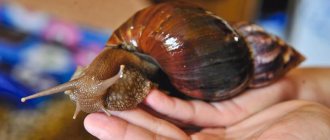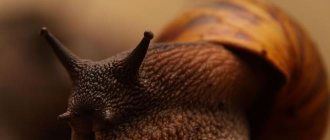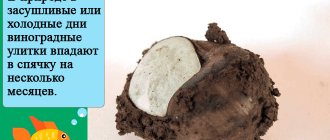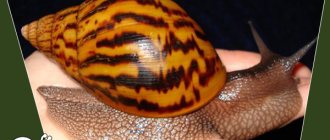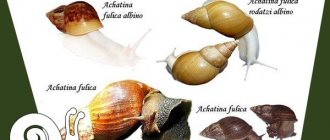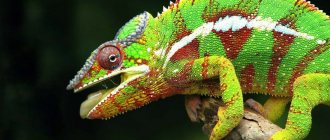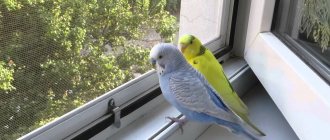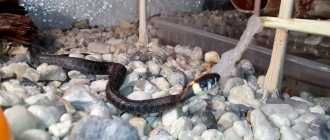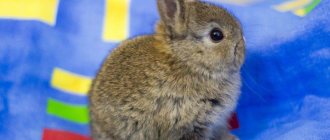You won’t be surprised by snails in a home terrarium. Completely different mollusks become pets - helix, chains, Achatina, Limicolaria, Caracolius and many others. But, in order for your pet to actively grow and feel healthy, it needs to create certain conditions. Anyone who wants to get such an exotic pet should choose a representative of an unpretentious and hardy species as their first snail. And only after a successful experience should you get a more capricious mollusk. We will talk about one of these species, which is suitable for beginner snail breeders, in our article. This is the Achatina Fulik snail.
Description
The homeland of Achatina fulica is East Africa, its range has spread to other continents. In some countries, keeping and breeding snails is prohibited. Representatives of the fulica species have different colors: the shell is light or brown with a yellow or reddish pattern. The shell is conical in shape and consists of 7–10 whorls. The body can be light, yellowish and dark. There are 4 tentacles on the head: the long ones serve as eyes, the short ones serve as a sensory organ that helps to perceive odors. The sense of smell is well developed.
Size
The maximum size of an adult is 35 cm in length and 15 cm in width. Shell up to 15–20 cm. Weight up to 600 g.
Behavior
The active period of Achatina fulica occurs at night; the snails feed and crawl along the walls of the aquarium. During the day, mollusks sleep, hiding in a shell. Adults are less mobile than young ones. Snails are capable of covering long distances. They are not a gregarious species; communication between individuals occurs during mating. The olfactory organs play a major role in the perception of the surrounding world.
Life cycle
Sexual maturity occurs at 6–15 months. Achatina fulica is a hermaphrodite. A minimum of two individuals are required for mating. A large snail acts as a female. Self-fertilization is possible in rare cases when the population is low. A fertilized snail can produce offspring over the next 2 years. There are 200–300 eggs in one clutch, which Achatina can lay every couple of months. Achatina fulica grows actively for 2 years, then growth slows down. They do not need to hibernate.
How long do they live?
Representatives of the Fulika species live up to 10 years with good care.
View this post on Instagram
Posted by mollie (@mollierosepowell_) Jan 3, 2022 at 1:03 am PST
Subspecies
Since the diversity of gastropod species has not been sufficiently studied, completely different information can be found in different sources. We will try to list the species of Achatina fulica, some of which live remarkably well in domestic conditions, while others are known only from shells from museums and about which practically nothing is known.
- Achatina fulica fulica;
- Achatina fulica var. hamillei;
- Achatina fulica var. hamillei f. rodatzi;
- Achatina fulica var. hamillei f. rodatzi albino body;
- Achatina fulica var. "White Jades";
- Achatina fulica castanea;
- Achatina fulica coloba;
- Achatina fulica sinistrosa;
- Achatina fulica umbilicata;
- Achatina fulica rufensis.
Achatina fulica fulica, Achatina fulica var. hamillei and Achatina fulica var. "White Jades" can most often be found in private collections.
Achatina fulica fulica (Achatina fulica standard)
The color of the shell can be varied. Mostly dark brown or black stripes on a yellow or white background, uniform brown or reddish brown. The columella can vary from white to bluish white. Body color can also vary from light brown to brown-black.
Achatina fulica var. hamillei (Achatina fulica hemeli)
Hemeli differs from standard Fulika in the color of its apex. Fulica Hemeli has a pink apex. In addition, the color of the shell may be more variegated. Columella white.
Achatina fulica var. hamillei f. Rodatzi (Achatina fulica rodatia)
These snails have a light albino yellow shell, which creates an impressive contrast with the dark body of the mollusk.
Achatina fulica var. hamillei f. rodatzi albino body
Rodatia albino body is a completely albino form with a light shell and white body color. Representatives of the albino body subspecies have yellow legs with age, which is associated with the presence of the pheomelanin pigment.
Achatina fulica var. "White Jades" (White Jade)
This subspecies has a standard shell color, but mostly with a more distinct striped pattern. The base color is yellowish, the stripes are reddish-brown to mahogany. The body is completely white. Columella is also white.
Conditions for keeping Achatina fulica
Achatina does not require a lot of care and additional equipment, a comfortable temperature is 25–28 degrees, humidity is 60–80% (when keeping an adult, the maximum humidity level is up to 65%). Feed Achatina, clean the terrarium in a timely manner.
There is no need to bathe Achatina, the maximum is to spray it when harvesting. Their body is slimy, dirt does not remain and does not harm the pet. Achatina are big fans of burrowing into the ground, so they are always dirty. And while swimming, you can damage the connection between your body and the sink.
Aquarium or terrarium
Place Achatina in a rectangular aquarium, terrarium or other container. Holes in the lid are not needed, since the air in the terrarium must be constantly humid. The indicator is condensation on the walls. If the terrarium has holes, the air will dry out. The snails practically do not need it - they are quite satisfied with what gets into the terrarium during feeding and cleaning.
Offspring
Babies are born completely independent and do not require any special care. They are kept in the same way as their parents.
Young individuals are in good health and survive in poor housing conditions and insufficient nutrition. Even in such conditions, they begin to reproduce and lay eggs early.
The average lifespan of Achatina Fulika in nature is 5-7 years. When kept in captivity, poor conditions and frequent clutches lead to wear and tear on the body. And already at the age of 1.5-2 years, these gastropods experience old age and death.
Therefore, it is very important to create the necessary conditions for keeping Fulikas from a very early age and create the right diet. In addition, prevent early propagation and plant in a timely manner. In this case, you can increase the pet’s life to 3-4, or even more years. It is not recommended to transport, sell or suddenly change the conditions of keeping snails older than one and a half years old. Fouls, most often, react very negatively - they get stressed, go off the rails. Unfortunately, it is almost impossible to cure them and they die.
Young fowls need stable conditions, because any changes lead to growth stagnation and the appearance of corresponding marks - scars on the shell, which spoils the appearance of the pet. Achatina Fulica should be planted when young and kept individually until they are fully formed and have completed active growth. This is done to avoid early reproduction and premature aging and wear and tear of the body.
Young individuals are not picky eaters and will eat the offered treat. But they especially love cucumbers and lettuce.
Growing snail organisms require increased amounts of calcium. Don’t forget about protein supplements and grain mixtures.
Feeding
Plant foods predominate in the diet:
- non-acidic varieties of apples;
- cucumbers;
- lettuce leaves;
- bananas;
- beet;
- potato;
- tomatoes;
- carrot.
Calcium, necessary for maintaining the strength of shells and normal growth, fulica is obtained from eggshells and special chalk. Grind them into powder. Calcium supplement can be placed separately or sprinkled on food. Calcium should always be available.
You can also give sepia - this is what snail breeders often use. The main thing is that there are no artificial additives or dyes.
Add protein food (dried gammarus and daphnia) less often. If a snail stops eating protein, it may get sick. You need to give a pinch of protein food 1-2 times a week.
It is not recommended to serve spicy, sour, sweet and salty foods; such foods can lead to the death of the mollusk.
Nutrition
Achatina feed on plant foods. Young snails choose green plants, while adult snails prefer dead and rotting plants.
At home, Achatina happily eats not only greens, but also vegetables, fruits, mushrooms, and cereals.
To form a strong shell, snails need to be given calcium. In the absence of calcium in the diet, Achatina can feed on each other's shells.
In order for Achatina Fulika to be active and healthy, she needs to be given grated eggshells, bone meal, sepia, food chalk, gammarus, and shell rock.
Of the vegetables, Achatina Fulika loves cucumbers most of all. You can also give zucchini, carrots, pumpkin, cabbage, tomato, peas, and corn.
Fruits include apples, pears, and bananas.
Diseases
Achatina rarely gets sick. With a lack of calcium, the shell is destroyed. Injury may occur if dropped or handled incorrectly. Never pick up a snail by the top of its shell; let Achatina fulica crawl onto your hand on its own. If your snail is chewing on a shell, adjust its diet and make sure your pet has enough free space. In unsanitary conditions or poor ventilation, snails are susceptible to parasites. If the snail refuses food, becomes lethargic, a white coating appears on the shell, or small translucent worms are visible near the snail’s body, immediately remove the sick individual. Rinse the terrarium thoroughly and replace the soil.
Reproduction
Growing Achatina at home is quite easy. Achatina Fulica snails are hermaphrodites. This means that they have both female and male reproductive organs. For mating, 2 mature individuals are required.
Snails become sexually mature at the age of 6 months. But such young individuals rarely mate, since the snail’s growth stops during the breeding season.
If you have a choice about whether to get Achatina, you can read the article Benefits of snails.
Photo gallery
Decorating a terrarium for a snail
The snail's home can be decorated with natural and artificial accessories. Interesting twisty driftwood and branches, cork bark or artificial aquarium plants. You can decorate an aquarium with Achatina with live plants or sow seeds of mustard, wheat, oats, be prepared that over time they will be eaten.
Be creative when decorating your snail's home. Avoid stones in the terrarium, as if a snail falls on them from a height, the consequences can be fatal.
You can stick a poster on the back of your terrarium with different images on it, such as plants, cities, mountains, cartoon characters.
Plastic flower pots (clean and empty) make an excellent hiding place for your snail to nap and rest during the day. Avoid using those made of ceramic or stone.
Bathing or snail hygiene
Water procedures bring a lot of positive emotions to Achatina and their owners. You can gently wipe the strong shell and delicate body of the mollusk with a soft brush or sponge. To bathe snails, use clean boiled or filtered water, which is poured into a shallow container. Never keep your snail under a tap or in a deep bowl when their breathing hole becomes full - they will drown.
After bathing, gently dry the sink with a towel and lubricate it with natural vegetable oil (olive, pumpkin). If your terrarium has a drinking bowl with boiled water, make sure it is clean, as the snails will constantly “hang out” in it.
Never wash your snail with soap.
Snail cleaning
It is carried out once every 3-4 weeks, depending on the size of the terrarium and the number of snails living in it. Wash the terrarium, bowls and decor only in warm water, then pour boiling water over everything. Replace all or part of the substrate, branches and snags. Some substrates can be processed and reused, but are easier to replace.
Varieties of Achatina
Achatina is a genus of mollusks that includes several dozen species of large pulmonate snails.
All varieties have a beautiful appearance and bright colors. They are distinguished by modifications of the shell, color, and behavioral characteristics in terrariums.
Representatives of the genus are subject to the possibility of giving birth to an individual suffering from albinism. Albinos carry a white shell on their back and do not grow as large as their counterparts.
The most common Achatina breeds are as follows.
Fulika
The bright yellow snail is relatively small in size. She has a very good appetite, and, by and large, she doesn’t care what she eats. It requires an environment with a body of water or simply high humidity. Knows how to get along in a group, when frightened it makes a squeak and tries to hide in a shell.
Reticulata
Light yellow, almost white snails, their speed is noticeably higher than usual, which can be expected from mollusks. They are unpretentious in their diet and can learn to eat by the hour. From morning to noon they are extremely active, and after lunch they fall asleep. It is believed that they can distinguish the owner, or the one who gives food, from all other people.
Immaculata
Outwardly it resembles a standard large snail. All metabolic processes in her body are slowed down, so this mollusk will never grow more than 160 mm in length.
Albopicta
The opposite of the previous exhibit. It grows quickly and eats a lot. Curiously extends its head towards moving objects, but hides when touched.
Lemon Achatina
A snail with a white body and a bright yellow shell. But this is far from its most important feature. It differs from all other Achatina breeds in that it does not lay eggs, but gives birth to live young. As a result, its fertility is lower than that of its counterparts, but is not radically different. Prefers to be nocturnal.
Brown Achatina
The largest representative of the species. Considered the standard giant snail. They need water treatments at least once every two weeks - these mollusks love to swim.
Zanzibarika
They are not particularly friendly to their neighbors. Often there are cases when one gnaws on the shell of another. She is demanding about living conditions; if they do not suit her, she goes into hibernation. Rarely found in private homes due to restrictions on living conditions.
Achatina vulgaris
It is also called “tiger”. The main color of the shell is orange. In addition, there are black stripes on the carapace, which evokes an association with the color of a tiger’s skin. The behavior of individuals is not very diverse: they mainly sit in one place, occasionally moving in order to get to food.
